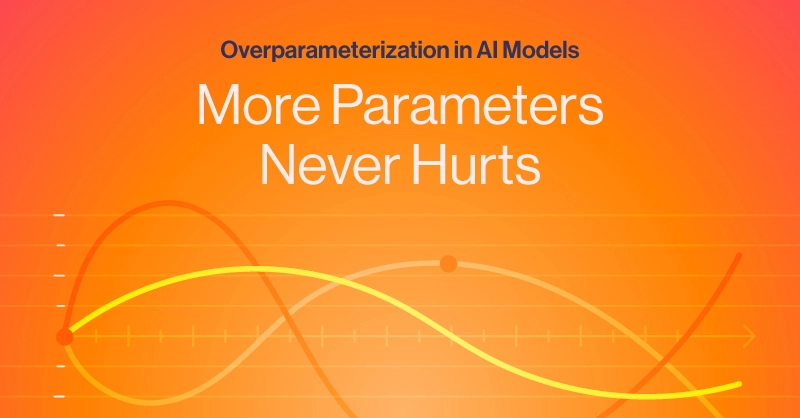Introduction
Developing and training a Machine Learning or AI model has always been an optimization problem. What are the most optimal epoch counts, larger or smaller batch sizes, and what’s the minimal number of parameters to reduce computational cost?
Bigger and more complex models have broken these norms. Larger and larger LLMs boast hundreds of billions; size, in some ways, has equated to progress. This scale has brought AI breakthroughs, raising an important question: Does overparameterizing our models improve performance?
Traditional machine learning and AI model training suggest oversized models would overfit the training data and fail to generalize. In practice, the reality is more nuanced. Modern deep learning has shown that overparameterized models can defy expectations, often performing better than smaller counterparts when trained correctly. In this blog, we will go over the benefits of overparameterizing your models to extract better generalization and robustness, and how more parameters are a gamble worth the risk.
What is Overparameterization in Machine Learning and AI Models?
Overparameterization refers to designing machine learning models with more parameters than necessary relative to the training data. Oversized models unlock greater representational power and flexibility, even if it seems counterintuitive from a traditional standpoint, with risk of overfitting.
Overparameterization gives engineers the room to build models that push the boundaries of what machines can learn. The key is in balancing this scale with techniques that prevent overfitting and ensure the extra capacity leads to real-world utility.
Benefits of Overparameterization in AI Models
With proper training, overparameterization offers:
- Easier training dynamics: Larger models are often easier to optimize. The abundance of parameters creates smoother loss landscapes, helping gradient-based methods find effective solutions.
- Improved performance on complex tasks: Overparameterized networks can capture highly intricate patterns and dependencies, making them well-suited for tasks like language understanding, image recognition, and scientific modeling.
- Unexpected generalization: When trained correctly, these models often perform well on new, unseen data, even though they have enough capacity to memorize the training set.
- Flexibility for fine-tuning: A large model trained on broad data can be adapted to specialized tasks with minimal additional data, thanks to its expansive representational capacity.
Risks of Overparameterization in AI Models
The risks and downsides of overparameterizing are:
- Overfitting and sensitivity to training data: With too many parameters and guardrails, the model can memorize training instead of learning patterns, which defeats the purpose of overparameterization. It can latch onto noisy data that is irrelevant to generalization.
- Higher computational resources: Larger models with additional parameter weights to calculate will require more processing power and time to train.
Mitigating the Downsides of Overparameterization
Overparameterization is an intentional design choice. Use these proven strategies to ensure your large and overparameterized models generalize well and avoid common pitfalls.
- Regularization techniques: Methods like weight decay, dropout, and batch normalization constrain the model during training, discouraging it from memorizing noise in the data.
- Careful optimization: Using advanced optimizers and learning rate schedules helps navigate the complex parameter space and avoid overfitting.
- Large and diverse datasets: Feeding the model vast amounts of varied data provides the raw material it needs to learn meaningful patterns rather than superficial correlations.
- Early stopping: Monitoring validation performance during training allows engineers to halt the process before the model begins overfitting.
- Model pruning and compression: After training, unnecessary parameters can be trimmed away to reduce complexity and improve deployment efficiency without sacrificing performance.
With these techniques, the immense capacity of overparameterized models becomes an asset instead of a liability. The goal isn’t to avoid large models but to ensure their size translates into robust, real-world performance.
Overparameterization in Modern AI Models
Many of today’s most powerful AI systems are built on extreme overparameterization. Models like GPT, BERT, and Vision Transformers contain billions or trillions of parameters. This scale is not accidental. Larger models trained on massive datasets tend to uncover richer representations.
These oversized architectures excel because their sheer capacity allows them to capture subtle patterns and relationships in data. Combined with techniques like pretraining and fine-tuning, they serve as flexible foundations for a wide range of tasks, from chatbots and translation systems to medical imaging and protein folding.
This insight has driven a new era of AI development where overparameterization is not only accepted but essential for achieving state-of-the-art results. Even if we aren’t building extremely large models, perhaps a surplus of parameters in even the less complex models can contribute to an increase in performance.
Conclusion
Overparameterization has become a defining feature of modern AI that enables models to learn complex patterns and deliver state-of-the-art performance. When paired with the right techniques, oversized architectures can generalize well, adapt to diverse tasks, and drive breakthroughs across industries.
Training your own large AI model? These systems are computationally expensive. Without the proper high-performance hardware, all the work into developing your AI system will be hampered by slow training times and inference speed. Configure a SabrePC 8x GPU compute server to facilitate and accelerate AI training today.


